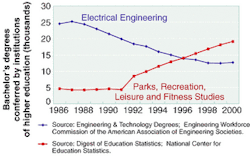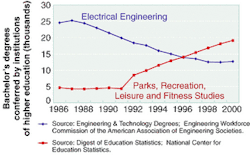Optical workforce problem calls for individual and community action
Notwithstanding the economic recession, the field of optics and photonics has "workforce problems," according to Duncan Moore, a former presidential science advisor and OSA president, who currently heads the Center of Excellence in Photonics (Rochester, NY). He is working with OSA and SPIE to create an initiative in optics/photonics. In his plenary address at the annual meeting of the Stanford Photonics Research Center (Palo Alto, CA) in September, Moore characterized the optics workforce problem as a shortage of people with advanced degrees in optics aggravated by an educational system that is not preparing young people to obtain technical degrees.
null
Moore estimated that the U.S. only produces about 150 doctorates in optics each year, compared to about 800 doctorates a year in computer science, and current trends in education are likely to make the problem worse. The U.S. has a relatively high per-capita percentage of college graduates (on the order of 22%), but only 5% of U.S. undergraduate degrees each year are in engineering. In contrast, China, with a per-capita percentage of college graduates an order of magnitude lower than the U.S., reports a much higher percentage of degrees in engineering—roughly 46%.
Fewer undergraduate degrees are granted in the U.S. in physics today than in 1957, Moore said. And he characterized electrical engineering as a "loss leader" among undergraduate degrees, because it has dropped from about 25,000 degrees a year in the 1980s to about 12,000 in 1999 (see figure). At the same time, the number of undergraduate degrees granted in parks, recreation, leisure, and fitness studies has climbed from the low thousands in 1987 to surpass electrical engineering in 1996 and is continuing to climb rapidly. "That says something about the priorities of our society," he said.
The next ten years
The paucity of doctoral degrees in photonics begins prior to the undergraduate level, however. The U.S. also has an increasingly severe shortage of math and science teachers in grade schools (see Laser Focus World, August 2000, p. 96). The time to do something about this is now, he said, because "all the math and science teachers for the next ten years are already in the school system."
Effectively addressing the photonics workforce problem will require collective action by optics professionals in establishing a national initiative-based program, and individual action by those same professionals in communicating with educators and community groups, Moore said.
"Optics and photonics right now are like computer science was in the 1970s," he said. But computer science has now developed into its own academic departments and disciplines of study because people in that field made compelling public arguments about the economic, social, and national-defense importance of information technology.
A 1998 report by the Committee on Optical Science and Engineering (COSE) pulled together the information that would have been needed to launch such an initiative in optics. But there was no attempt in the U.S. to sell it as a national mission, he said. Germany and Korea, on the other hand, made huge investments in optics based on the COSE report.
To pick up where the COSE report left off, OSA and SPIE are organizing a National Optics Initiative to do the type of government lobbying that has garnered support for medical science and nanotechnology. The other tasks for optics professionals will involve working through teachers in their communities to assist in optics education and to raise awareness about optics, he said. It will also involve addressing local groups such as Rotary Clubs, which can be tough for engineers who are only used to discussing optics with other engineers.
The former presidential science advisor confessed to feeling more nervous talking to a Rotary club than he had ever felt during a national presentation. Explaining his scientific perspectives to nonscientific community-based audiences remains difficult, but it is the type of communication that needs to take place, he said.

